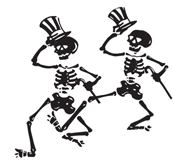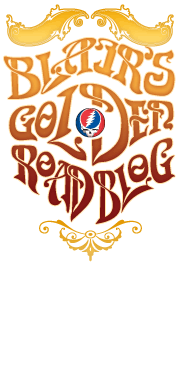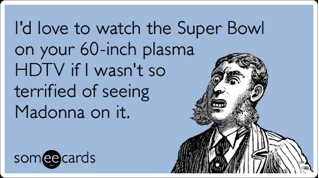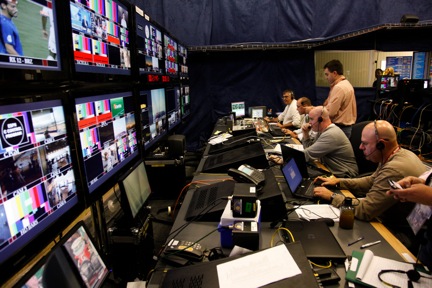As I watched Madonna’s dumb, hopelessly over-the-top, obviously lip-synched performance during halftime of the Super Bowl, I wondered what the Grateful Dead might have done if they’d stuck around this long and were asked to play at that outsized and cartoonish extravaganza. (OK, we’re in Fantasyland here: Jerry is still alive and somehow Dead Heads in the corporate wing of the NFL convinced their bosses and the network carrying the Super Bowl that the “legendary” Grateful Dead would be perfect to fill that 17-minute slot between the 12th Bud Light commercial and this year’s shameful sex tease from GoDaddy.com. After all, The Who and Paul McCartney had done it, and Led Zep still wasn’t interested.)
The promos the network ran for the Dead’s halftime appearance in the weeks leading up to the Super Bowl looked promising. There they were, happy and smiling, belting out the triumphal closing chorus of “Touch of Grey”—“We will survive!”—for a stadium full of tie-dye-clad revelers singing along on a sunny summer afternoon. Quick cut to hippies dancing in Golden Gate Park, 1967, then to a brief glimpse of Kesey’s bus, then back to the Dead show, where the band and crowd are loudly crooning, “What a lonnnnnng strange trip it’s been!” Fade in Grateful Dead “Stealie” logo” over cheering fans and… fade to black. Dynamite!
The on-field rehearsal the night before went well. The band had worked up a snappy jam-free medley of a truncated “Truckin’” (minus the “Livin’ on reds, vitamin C and cocaine” verse and the second “Sometimes the light’s all shining on me” bridge); “Touch of Grey” (pruned by two verses and a bridge); “Sugar Magnolia” (during which 500 clean-cut local teenagers decked out in matching tie-dye shirts and pressed jeans, each carrying a single plastic daisy, charged onto the field in front of the band’s peace-symbol-shaped stage and imitated frantic hippie dancing to simulate a Dead Head crowd); and a feel-good finale of “Not Fade Away” (which ended with the kids moving into formation to spell the word “LOVE.” Awww, how sweet! Jerry was laughing as he left the stage; Phil scowled and shook his head. In the video truck parked outside the stadium, everyone looked pleased and satisfied.
The next day—Super Bowl Sunday—everything seemed to be going beautifully with the telecast. The game was exciting—how ’bout that play right before halftime where the quarterback tried to hide the ball under his shirt; that never works! The commercials were incredible—remember the one with the biker, the nun in a bikini and a dead koala bear? LOL! Before the teams had even made it into their locker rooms, the halftime stage crew swarmed onto the field and worked like ants on steroids rolling the many enormous pieces of the stage into place. The stadium was buzzing with excitement as the house lights were extinguished, multicolored spotlights began moving over the crowd in fast sweeps, and the voice of none other than Morgan Freeman solemnly intoned over the P.A.: “Ladies and gentlemen … direct from Haight-Ashbury in San Francisco … the last survivors of the turned-on ’60s … the Grateful Dead!”
There was a deafening roar from the crowd, the lights that had been flashing and flying over every inch of the cavernous stadium’s three decks suddenly came together at once in a single giant beam of rainbow light that drenched the stage in color, and fireworks behind the band platform exploded into the night sky. Incredible! And then…
Well…nothing. Mickey hit his snare a couple of times, checking to see if it was properly tuned. Jerry stood facing his stack of amps, casually lighting a cigarette and joking with Steve Parish. Bob was kneeling intently in front of his effects setup, twisting knobs and flicking switches, trying out a MIDI sound that was like a burp mixed with an oboe. Phil warmed up with a dissonant Schoenbergian 12-tone row on his bass, while Billy played the “Alley Cat” rhythm with brushes on his hi-hat. And guest pianist Elton John, who had worn a jewel-encrusted Day-glo jump suit at rehearsal, was nowhere to be seen.
After 45 seconds of this, the director in the video truck was in full freak-out mode, letting out strange squeals and screams and attempting to tear out at what little hair he had left. “It’s cool,” Dead manager Danny Rifkin, who had been lured out of retirement for the Super Bowl gig, casually told the director. “Sometimes they can be a little slow getting into it.” Right at that moment, Garcia put down his ciggie, turned to the other players, Sir Elton arrived at his bench to ecstatic cheers, and the Dead charged into…. Ba-da-da-duh, ba-da-da-dah… “Dark Star”!
“WHAT THE HELL IS THAT?” the red-faced director shrieked in Rifkin’s direction, except he didn’t say “hell.”
“That’s ‘Dark Star,’ man. What a treat for the Dead Heads. They never open with that!”
“But … but … what about ‘Truckin’’?” the apoplectic director sputtered, his eyes bulging.
“I guess it didn’t feel right,” Rifkin said. “Or maybe they’ll play it later. Don’t worry, they’ve got a clock.”
Indeed, a bright digital clock tucked below Bobby’s front monitor speaker gave a read-out of how much of the band’s 17-minute allotment was left. After just a minute and half of “Dark Star” craziness—surely the shortest version ever—the group lurched into the elephantine lumber of “Victim or the Crime” and Bob came to the mike and shouted: “Patience runs out on the junkie / The dark side hires another soul…” By this point the director was speechless, staring at Rifkin with a wide-eyed, panicked look.
“It’s very topical,” Rifkin said calmly with a smile. “The line about ‘the dark side’ will grab all those kids who are into vampires. You know, the Twilight crowd.”
The band mercifully played just a single verse and then shifted gears again. All right—there’s a riff everyone knows! Garcia came up to the mike: “DRIVING THAT TRAIN, HIGH ON CO-CAINE!”
Over the director’s intercom in the truck came the voice of the network president: “NO! NO! NO! NO! FIX THIS … NOW!”
But the Dead were already onto the next part of their medley, a furious plunge into “The Other One” that so disoriented one of the cameramen onstage that he fell backward onto a female sideline reporter who had been watching the show with a look of disgust on her face. Elton kicked his bench behind him, hitting another cameraman, and pounded the keys with his elbows. In the truck, the director was alternately blubbering and taking deep breaths, calling out random camera numbers without even looking at the shots on his monitor wall. It looked very trippy at home!
As “The Other One” gave way to the opening strains of “Truckin’”—finally!—the director gathered himself together enough to instruct over an intercom, “OK, let’s get those kids out there!” And right as Bobby was staring heavenward, in vain, for the lyrics to the first verse, that sheepish, confused look on his face, hundreds of people poured out from one of the tunnels leading to the field and filled up the area in front of the stage. But wait—these weren’t the kids from the previous day’s rehearsals. These were real Dead Heads!
“We figured it would be better to have some of our fans out there,” Rifkin offered before the stupefied director could even ask. “It’s more authentic, dontcha think?”
The cameramen around the stadium instinctively started to zoom in on the dancing hippies, and that’s when America really got an eyeful: There was a guy selling veggie burritos out of a knapsack, two scraggly bandana-wearing dogs chasing each other through the crowd, a woman dressed in Guatemalan togs and straw hat holding a sign that read “NEED A RIDE TO DENVER,” a row of tapers who jockeyed and jostled for the best position exactly 28 feet in front of the stage, a naked dude who rolled around on the NFL logo at the 50 yard line, rail rats and hallway twirlers, little kids wandering around blowing bubbles and even Wavy Gravy walking his ubiquitous rubber fish on a leash. A shirtless long-hair wearing leather pants but no shoes somehow wandered onto the stage, and with his right finger in the air, appeared to ask Jerry if he had an extra ticket. Garcia chuckled and looked away as Kidd Candelario tackled the clearly disoriented lad and “eased” him from the stage.
With just two minutes left on the clock, the group abruptly abandoned “Truckin’” as only the Grateful Dead could—bass notes flopped awkwardly over guitar clams, cymbals crashed and Elton smashed his forehead onto his keyboard so hard his enormous pink plastic flamingo sunglasses went flying onto Billy’s floor tom. Out of that cacophony came the unmistakable beat of “Not Fade Away.” In the truck, Rifkin laughed and said to the director, “See? Just like a Swiss watch! You gotta have faith.”
The crowd was way into it, too, and clapped along loudly. It had taken a while—16 minutes—but the band had hit its stride at last! The director even smiled slightly as he instructed Camera 4 to shoot a pair of very drunk-looking women in crop tops singing along and boogieing in their very expensive seats.
“Look, they’re going to do the ‘LOVE’ spell-out!” the director said excitedly as he saw members of the crowd starting to arrange themselves in front of the stage. As the band came to their mikes for the last unison a cappella lines—“Know our love will not fade away…” the director barked into his headset, “Cameras, 2, 5, 6 and 8—get on that crowd!”
The hippies miraculously formed into a perfect “L,” and the director giggled. Then the next bunch assembled into an “S.” All of a sudden the director blanched. He looked over to Rifkin with a puzzled look, but the manager was gone; the door to the truck was already swinging closed. The director muttered under his breath. “L … S …” and he cocked his head at one of the monitors to see what letter was coming next.
“Oh, my GOD!” he shouted, “CUT TO COMMERCIAL! CUT TO COMMERCIAL!”
Only the 80,000 on hand in the stadium got to see the third letter. Oh, and the millions who saw it on the Internet the next day.
Once the game was over, the director drove himself to a nearby asylum. Jerry cheerfully signed autographs outside the winning team’s locker room. On the field, still covered with victorious players and hundreds of members of the press, Bill Walton blithely walked between the MVP quarterback and dozens of press interrogators, leaned his head down next to the quarterback’s, and, grinning, loudly proclaimed into a sea of cameras: “Best … Super Bowl … halftime … EVER!” and flashed the peace sign.
For each of my February blogs, I’m highlighting five entrants from the Dead Covers Project that have particularly caught my eyes and ears. Here are this week’s Fab Five:
Kacey Cubero:“Stella Blue.” According to a note under the video, Cubero was nine months pregnant when she cut this wonderful version of “Stella” in mid-January—so maybe there will be a little Cubero crying in the background of her next video. She does a fine job with a tough song, and the five-piece band that backs her up—acoustic guitar, hollow-body electric, standup bass, dobro, fiddle—colors the song beautifully. I’d love to hear more from them.
Nathan David:“Eyes of the World.” An exceptional guitarist who lives in Australia, David plays this fantastic version of “Eyes” solo with live loops. It's hard to keep the momentum of a tune like this going for 12 minutes, but he makes it look easy, unleashing fluid leads that vary in tone and attack. Make sure you stick around until the end to hear his coda, with electronics and moody bottleneck. (Turn it up!)
D-Madness: “Shakedown Street.” I’ve always wondered what “Shakedown” might sound like performed by an African American funk band. Well, here it is, courtesy of Austin multi-instrumentalist D-Madness. It’s got the silky vocals, the thumping bass, the smooth guitars; very cool. The video is just still photos of the musicians, but it’s worth checking out for the audio track.
Von Johin: “Visions of Johanna.” This may be the strangest conceptual video we’ve received, but it’s also one of the most evocative. As singer/acoustic guitarist Johin lays down a moving, terrifically rendered version of the Dylan classic, the visual (created by Bryan Oh) is a slow journey through some sort of surrealist videogame landscape still-life, with a solitary woman standing amidst dusty books, an old fashioned bicycle, a bird skeleton, a weathered upright piano and various other unusual objects. Dylan would be proud; so would Jerry.
Mark Muller and the Dead-On Choir: “Attics of My Life.” Captured at the Count Basie Theater in NJ, this is a striking note-for-note version of “Attics” with spare instrumentation and just about perfect vocals. This is an extremely difficult song to pull off this well—just ask the Grateful Dead!




